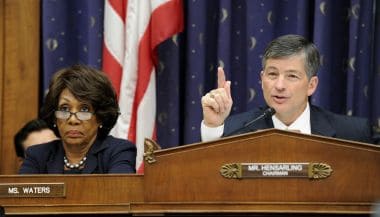Introduction

In 2013, Scott Talbott, then-chief lobbyist for the Financial Services Roundtable, likened the signing of sweeping financial reforms under Dodd-Frank in 2010 to “halftime.”
Even now, on the fourth anniversary of President Obama’s signing of Dodd-Frank into law, bank lobbyists and a core group of lawmakers dubbed by the Center for Public Integrity in April as the “banking caucus,” have made it clear that there is still time left on the clock to undermine key provisions in the financial reform law.
Rep. Jeb Hensarling, R-Texas, named by the Center’s April report as the captain of the banking caucus, offered what might serve as a pep talk on July 16.
“We can never, ever accept a Dodd-Frank world, nor should we,” he said at a conference organized by the Mercatus Center and the Cato Institute.
Hensarling, chairman of the House Financial Services Committee, and the 10 other members of Congress featured in the Center’s investigation, have done their best to derail Dodd-Frank.
At least 30 bills have been proposed to the House during the 113th Congress, aimed at chipping away at aspects of Dodd-Frank. Members of the banking caucus sponsored or cosponsored 20 of those laws. At least 16 have been referred to the House Financial Services Committee and three have been passed to the Senate.
Most measures will stall upon reaching the Senate Banking Committee, which supports Dodd-Frank.
The Consumer Financial Protection Bureau, created by Dodd-Frank, is a favorite target for opponents of financial reform. Ten proposed laws over the past year have been aimed at disassembling some aspect of the CFPB.
The bills range from the trivial to the systemic. The Bureau Research Transparency Act, for example, asks that the CFPB provide any studies or data when publishing a related research study, while the CFPB Data Collection Security Act would limit the bureau’s ability to collect and hold important data.
Attacks on the CPFB have been steady almost since its inception. A proposal before the 112th Congress to change the CFPB leadership structure from a single director to a commission has resurfaced as the “Responsible Consumer Financial Protection Regulations Act of 2013.”
Another method to put the future of the CPFB in question is to change its funding. The House Appropriations Committee’s fiscal year 2015 Financial Services and General Government Appropriations bill includes a provision to change the bureau’s funding source from the Federal Reserve to Congress beginning in 2016. The bill passed the house on July 16.
Finance-related industries, related political action committees and dark money groups have donated almost $248 million to political campaigns, according to data from the Center for Responsive Politics, more than any industry.
While most of these proposals probably don’t have much of a chance of becoming law, when combined with the at least 50 appearances by senior CPFB officials before Congress, they do reflect the type of pressure that has made meaningful financial reform difficult.
According to the Davis Polk Regulatory Tracker, 45 percent of Dodd-Frank’s specific deadlines have passed without finalized rules.
Read more in Inequality, Opportunity and Poverty
Inequality, Opportunity and Poverty
The investment industry threatens state retirement plans to help workers save
States wrestle with impending retirement crisis as pensions disappear
After the Meltdown
Holder starts 90-day clock on potential prosecution of bankers
Finance executives who caused 2008 meltdown put on notice


Join the conversation
Show Comments